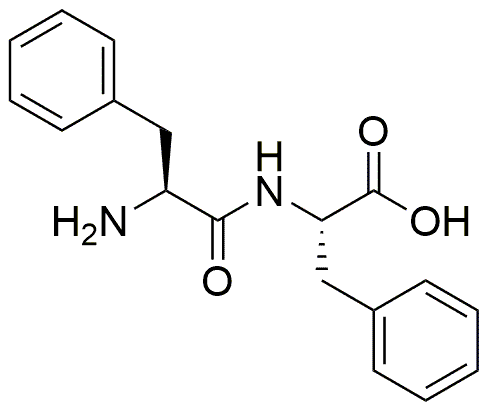Phe-Phe-OH is widely utilized in research focused on:
- Peptide Synthesis: This compound serves as a building block in the synthesis of peptides, particularly in the development of therapeutic agents targeting various diseases.
- Drug Development: It plays a crucial role in drug formulation, especially in creating compounds that can effectively interact with biological targets, enhancing drug efficacy.
- Biochemical Research: Researchers use it to study protein interactions and enzyme activities, providing insights into cellular mechanisms and potential disease pathways.
- Cosmetic Formulations: The compound is incorporated into skincare products for its potential anti-aging properties, helping to improve skin texture and elasticity.
- Nutraceuticals: It is also explored in the development of dietary supplements aimed at improving overall health and wellness, particularly in muscle recovery and growth.
General Information
Properties
Safety and Regulations
Applications
Phe-Phe-OH is widely utilized in research focused on:
- Peptide Synthesis: This compound serves as a building block in the synthesis of peptides, particularly in the development of therapeutic agents targeting various diseases.
- Drug Development: It plays a crucial role in drug formulation, especially in creating compounds that can effectively interact with biological targets, enhancing drug efficacy.
- Biochemical Research: Researchers use it to study protein interactions and enzyme activities, providing insights into cellular mechanisms and potential disease pathways.
- Cosmetic Formulations: The compound is incorporated into skincare products for its potential anti-aging properties, helping to improve skin texture and elasticity.
- Nutraceuticals: It is also explored in the development of dietary supplements aimed at improving overall health and wellness, particularly in muscle recovery and growth.
Documents
Safety Data Sheets (SDS)
The SDS provides comprehensive safety information on handling, storage, and disposal of the product.
Product Specification (PS)
The PS provides a comprehensive breakdown of the product’s properties, including chemical composition, physical state, purity, and storage requirements. It also details acceptable quality ranges and the product's intended applications.
Certificates of Analysis (COA)
Search for Certificates of Analysis (COA) by entering the products Lot Number. Lot and Batch Numbers can be found on a product’s label following the words ‘Lot’ or ‘Batch’.
Numéro de catalogue
Numéro de lot/série
Certificates Of Origin (COO)
This COO confirms the country where the product was manufactured, and also details the materials and components used in it and whether it is derived from natural, synthetic, or other specific sources. This certificate may be required for customs, trade, and regulatory compliance.
Numéro de catalogue
Numéro de lot/série
Safety Data Sheets (SDS)
The SDS provides comprehensive safety information on handling, storage, and disposal of the product.
DownloadProduct Specification (PS)
The PS provides a comprehensive breakdown of the product’s properties, including chemical composition, physical state, purity, and storage requirements. It also details acceptable quality ranges and the product's intended applications.
DownloadCertificates of Analysis (COA)
Search for Certificates of Analysis (COA) by entering the products Lot Number. Lot and Batch Numbers can be found on a product’s label following the words ‘Lot’ or ‘Batch’.
Numéro de catalogue
Numéro de lot/série
Certificates Of Origin (COO)
This COO confirms the country where the product was manufactured, and also details the materials and components used in it and whether it is derived from natural, synthetic, or other specific sources. This certificate may be required for customs, trade, and regulatory compliance.


